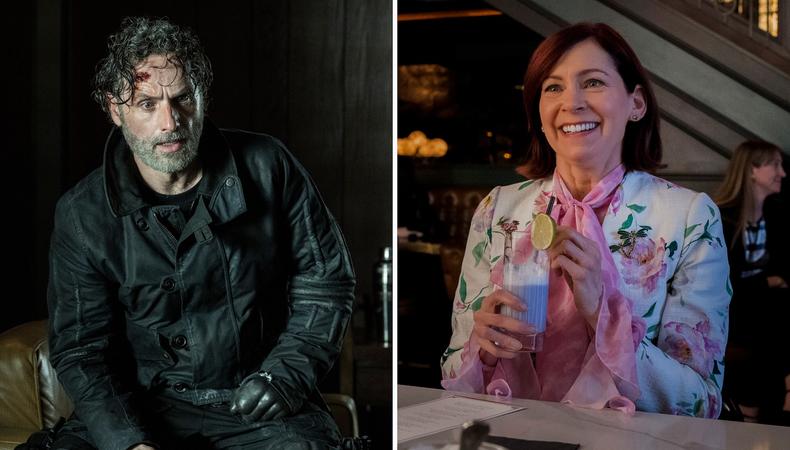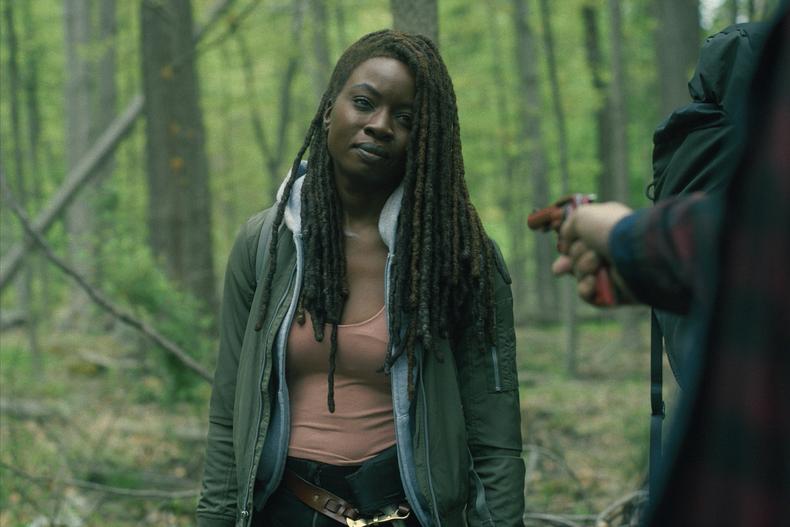
Photo Source: Gene Page/AMC/Michael Parmelee/CBS
In 2010, zombie slayer Rick Grimes (Andrew Lincoln) and New York lawyer Elsbeth Tascioni (Carrie Preston) made their debuts on AMC’s “The Walking Dead” and CBS’ “The Good Wife,” respectively. On the surface, a zombie apocalypse drama and a courtroom procedural may seem to be worlds apart; but this year, both characters returned to the small screen on a pair of spinoffs: “The Walking Dead: The Ones Who Live” and “Elsbeth.”
Join Backstage to access jobs you can apply to right now!
Ande Yung is the makeup department head on both series. “I do a lot of bloody stuff, and I do a lot of beauty stuff,” she says. “I feel pretty comfortable doing anything that gets thrown at [me].” Here, she talks us through revamping two beloved TV icons.
What’s it like to take on characters that started out on other shows?
My biggest thing is doing justice to the people who came before me…. We took a lot of care in making sure the scars and look of Rick Grimes for “The Ones Who Live” [were] accurate. I felt the pressure but also the excitement of being able to carefully research everything…. I spoke with the makeup department heads from past seasons [of “The Walking Dead”] and got as much information as I could.
[It was the] same thing for Carrie. [Elsbeth] is already established in “The Good Wife.” She’s the same character, but different. She’s almost reclaiming her independence in “Elsbeth.” She has more control over where she wants to be and where she’s going. We were able to go in a different direction and give her some freshness.
“The Ones Who Live” uses a lot of special effects makeup. What’s it like working on a project of this size?
I don’t advertise myself as a special effects makeup artist, but I do feel like, as a department head or any union makeup artist, part of your repertoire of knowledge should be cuts, how to apply prosthetics, and how to do certain things on a lighter scale. The beauty of “The Walking Dead” is that [special-effects makeup artist] Greg Nicotero’s company, KNB EFX, has been with [the franchise] since the beginning. They established what a Walker looks like and dictated the direction of what zombies are in the film and television industry.
Andy [Lincoln] loves all this stuff. He loves blood and gore; he loves sweat; he loves dirt. That helps when your actor loves all that stuff because…you don’t have to convince them this is the right direction. Andy will be like, “More, more! Pour blood on my head!”
You’ve done Instagram tutorials about the techniques you use to create scars, blood, and facial hair on “The Ones Who Live.” Why did you decide to make these videos?
First and foremost, I love sharing. If someone wants to know what I’m using, I’m like, “This is it. Here’s the name. It comes in different sizes. This is how you use it.” I get permission before I do any of these things from the producers. I will never compromise the integrity of a show by releasing information without having the go-ahead, and I won’t do it before something’s released.

Several department heads on “The Ones Who Live” worked on the original “Walking Dead” series. What was it like coming in as a newcomer to this family?
It was pretty incredible in the sense that people were so welcoming. Even when I had my first meeting with Andy and Danai [Gurira, who plays Michonne] over Zoom, it felt collaborative right off the bat—warm and welcoming.
Vincent Gideon, the hair department head, is unbelievable. He’s so easy to work with. [It’s the] same thing with [costume designer] Eulyn [Colette Hufkie]. She was like, “Do you want to come to see what I’m doing? Come take a look: This is what looks different from the other season.”
I’m not gonna say it’s rare, because I’ve had that in the past, but it just makes your job so much easier going in because you [can] focus on the work and not be self-conscious about what you’re doing.
Is there a difference in how you approach a network procedural like “Elsbeth”?
I don’t see much difference other than the content. The thing about “Elsbeth” is that you get different guest stars every episode, which is really fun. It’s like you’re doing a mini-story, even though there’s that consistent line and arc running through. [On] “The Walking Dead,” it’s all the same characters throughout the entire series.
After working on so many different genres, does anything ever come to you and you think, Oh, I don’t know what to do?
I do a lot of research. I think that’s a really important thing—coming to the table…having looked up what you’re doing, having looked up your actors, seeing what they’ve worked on before, what their comfort zones are, and what they lean toward. I think if you come to the table unprepared, it shows.
And the beauty of “Elsbeth” is that everyone has come prepared so far, and that’s what makes it feel seamless.
Can you discuss collaborating with Preston on “Elsbeth” and how her costumes impact the makeup?
I think the wardrobe does a lot of talking, and I very happily keep her palette on her face a bit more neutral because we never want to be charactery [or] clownish. She’s a very put-together, smart, quick, intelligent person. She’s able to put these outfits together that are bright and show her personality, but I don’t want to compete. I don’t want her to come on camera, and you’re like, [gasp!], because it’s just too much. We’re just a bit more restrained on the face.
Carrie’s a beautiful person. She shines from the inside out. So we keep her clean and bright and fresh. The fortunate thing about her having so many different colors is you can pretty much put any lip color on her and it’s going to match something she’s wearing. But, generally, she’s wearing a warmer tone close to her face; we do a warmer lipstick. If she’s wearing something cooler, we do something a little bit cooler. She can wear many different colors, and that makes my job so much easier.

What advice would you give to someone coming into the industry?
I started at Bloomingdale’s Prescriptives counter way before I ever got into the union. The beauty about that is I did so many different faces that weren’t movie stars, that weren’t models, that were just everyday people—and you learn so much technique that way. Then, as I progressed, I went to Make-Up Designory to learn about special effects. It’s always [about] educating yourself and constantly trying to stay on top of the trends.
When I’m hiring somebody…personality matters so much. A good attitude and being able to collaborate makes such a big difference. Of course, you have to have a certain level of makeup skills, but certain things can be taught. But personality makes such a big difference when you’re going to be with a group of people over a long period of time.
[Have] a great attitude, [be] willing to be a part of the team, and do what you have to do in order to make things work. My biggest piece of advice is just being a team player and having a good attitude.
“The Ones Who Live” was shot in New Jersey in the winter. What do you take into consideration when actors are filming outside in the cold?
When we first started shooting one of the first scenes, Andy was on top of the big trucks, and it was freezing. It was an overnight [shoot], and my main concern is keeping the actors as comfortable as possible while having to add freezing cold blood and sweat.
A lot of my job as makeup department head is making sure that the actors are as comfortable as possible so they can focus on what they have to do, whether that’s keeping them warm or warming the blood ahead of time—because I do have a cooler where it will keep things warm…. So when I’m spraying Andy or another actor [with blood], it’s not cold in the middle of a below-zero setting. [The blood is] at least somewhat warm so you’re not shocking them, because they still have to be able to stay in that mental state. They still physically have to be able to do the work.





